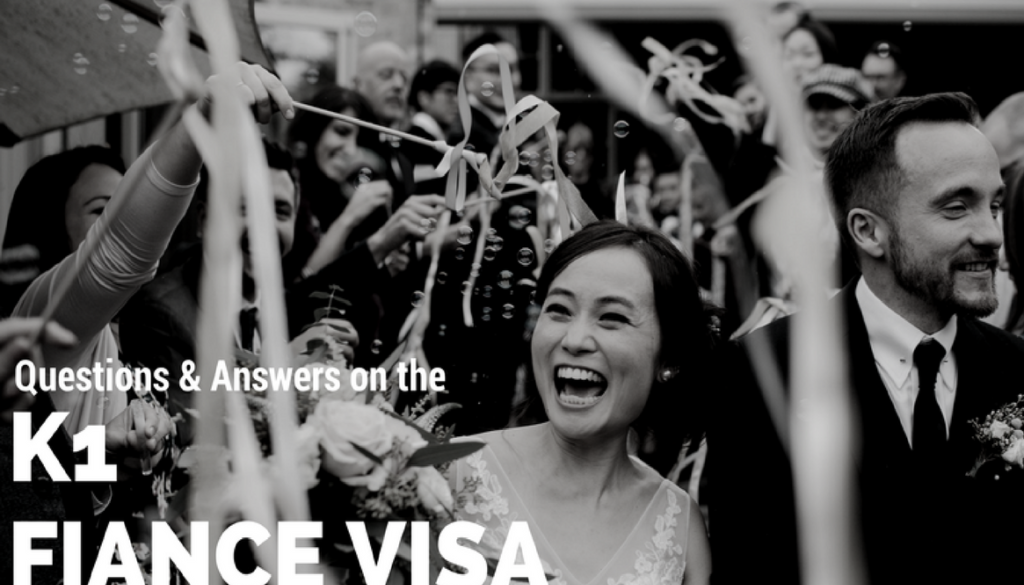K-1 Fiance Visa Step by Step (Updated 2024)
We're in Love! Now what?
Congratulations! If you are reading this, you probably met someone and fell in love. Exciting times! However, if you are reading this, chances are that person does not live in the United States. Tough situation–I’ve been there. This post will lay out one of the best options for getting your significant other to the United States–the K-1 fiancé(e) visa. In the first part, I answer some of the most common K-1 visa questions. In the second part, I provide a step-by-step breakdown of the fiancé(e) visa process. Feel free to skip around. Also, if you have questions about the K-1 visa process, give us a call at 503-749-7700 or write questions@pdximmigration.com. We charge $250 for our one-hour consultations. If you are thinking about pursuing an immigration process, a consultation with an experienced immigration lawyer is a good investment. Now, happy reading!
Questions and Answers on the K-1 Fiance Visa
What is a K-1 fiance visa?
With a K-1 fiance (also spelled fiancé or fiancée) visa, a U.S. citizen can petition for their fiancée abroad to come to the U.S. so they can get married.
Who can file a K-1 visa petition?
A US citizen can file a K-1 visa petition for his or her fiance abroad. A lawful permanent resident (green card holder) cannot. If you are a green card holder, you will need to either get married and pursue a spouse visa or naturalize before filing the K-1 visa petition.
How long will it take for my fiancée to be able to travel to the US?
Back when I first wrote this article (2017), fiancée visa processing times were 4-6 months. The fiancée visa process became much more popular, USCIS (the agency that processes the initial petition) slowed down, COVID, etc. Now (May 2024) average times just for the first part of the process are around 13 months (see screenshot below). This means, from the date of filing your K-1 fiancée visa petition to your fiancée’s arrival in the US, you are most likely looking at a wait of 1.5-2 years. However, If USCIS finds a problem with your petition or there is an issue at the embassy abroad, it could take much longer to process.

What if we don’t want to wait 1.5-2 years?
Can I file for a K-1 visa if we are already married but my husband/wife is still living abroad?
No. If you are already married, you will need to file a different visa petition for your spouse.
Why choose a K-1 visa petition instead of other visas available to couples?
Which visa is best for your particular situation depends on your goals as a couple. An immigration lawyer can explain your options and help you make an informed decision. A K-1 visa is often the best choice for a couple when a US citizen wants their fiancée abroad to come to the US but getting married abroad is not practical for the couple. An I-130 immigrant spouse petition is usually a better option if the couple would prefer to get married abroad and have the immigrant spouse travel to the United States with permanent residence (green card) at arrival. As mentioned above, this is a very important decision for your case and future and you should do a consultation with an experienced immigration attorney.
Can my fiance’s child(ren) travel to the U.S. too?
Yes, providing they are still under 21 years of age. A child under 21 whose parent is the recipient of a fiancée visa can qualify for a K-2 derivative visa. This is one of the benefits of the fiancée visa as opposed to the spouse visa—a separate petition for each child is not necessary. Any children under 21 will automatically be included with the initial I-129F petition to USCIS as long as you list them on the form. However, once the petition is approved and transferred to the National Visa Center, each individual traveling to the U.S. must complete a separate DS-160 form and pay a visa processing fee (currently $265). Each person will also need a medical check and, if the child is 16 or older, police clearance certificate.
Note: If your fiancée and the child’s other parent were previously married, most embassies require a legal document signed by the other parent giving permission to take the child to the U.S. to live permanently. Like all documents submitted to the embassy, you will need a certified, English translation of this parental consent document.
What are some of the other requirements to apply for a fiance visa?
In most cases, you and your fiance must have met, in person, during the last 2 years before filing the petition. Keep in mind that you will have to provide proof of this meeting. Examples of proof include flight documentation for a trip to visit your fiancée, pictures of the two of you together, receipts from your time in your fiance’s country, confirmation for hotel reservations, and stamps in your passport.
In addition to having met within the last two years, you must not have met your fiancée through the services of a marriage broker as defined by the International Marriage Broker Regulation Act. If you met your fiance through any sort of matchmaking service or online dating site, it would be a good idea to talk with an immigration lawyer about how to convince USCIS that your your meeting does not fall within the definition of a brokered marriage. NOTE: USCIS has been very skeptical of any couple that meets online. Many individuals who met on social media sites are receiving a Request for Evidence (RFE) asking for proof that they did not meet through a marriage broker.
If either you (the petitioner) or your fiance (the beneficiary) has been convicted of a crime, you may not be able to qualify for a fiancée visa. The immigration consequences of a criminal conviction are extremely complex. If either you or your fiance has a criminal conviction, definitely speak with an immigration lawyer before filing your petition.
Both you and your fiancée must be free to marry. What does it mean to be free to marry for immigration purposes? It means that you can provide documentation that any prior marriages were legally terminated by divorce, death, or annulment. A marriage is usually valid for immigration purposes if it was entered pursuant to the laws of the jurisdiction where it took place. For example, if you got married in Spain and your marriage complied with Spanish law, your marriage is valid under U.S. immigration law, even if Spanish marriage requirements are different from U.S. marriage requirements. The same is true for divorce. If you or your fiancée were previously married and then got divorced, the divorce is only valid if completed according to the laws of the place where the divorce was filed.
Both you and your fiancée must be able and willing to marry within 90 days of your fiance entering the U.S. Usually, this one is not a problem! However, it is very important that you not use the k1 visa in place of a B1/B2 visitor visa. Some people will apply for a fiancée visa after a partner is denied a B1/B2 visa, without the intent to marry upon the partner’s arrival to the US. This is a big mistake and could have serious consequences for any future immigration petitions. If you and your partner do not intend to marry within 90 days of arrival to the U.S., it is best to wait and not file a K-1 visa petition, or at least speak with an immigration lawyer prior to filing anything.
As the U.S. citizen petitioner, you must be willing and able to provide for your fiancée and convince the government your fiancée will not become a public charge (depend on the government for support). In order to do this, you must provide documentation of either sufficient income, assets, or a combination of both. Here are the official guidelines for 2024.
The K-1 Fiancée Visa Step-by-Step
What is the K-1 visa process?
Now that you know a bit about the requirements for filing a k1 fiancée visa petition, here is an overview of the steps involved in the process. Of course, no article is going to explain the process as well as a consultation with an experienced immigration lawyer. Reading the following will give you an idea of what’s to come and provide you with questions to ask during your consultation.
Step one: Determine eligibility
The US citizen should begin the process by meeting with an experienced immigration lawyer for a consultation. During this consultation, that lawyer should help determine whether you and your fiancée can qualify for a K-1 visa and discuss the potential alternatives if the K-1 visa is not the best fit for your situation. If your fiancée has any minor children, the lawyer should also explain the K-2 derivative visa process for your fiancée’s children.
Step two: Gather documentation
The evidence required to create a successful K-1 visa petition is different in every case. Generally, USCIS requires: valid passport, birth certificate, divorce or death certificate of any previous spouse, proof that you two have met in person during the last two years, proof that you two intend to marry within 90 days of your fiancée’s arrival, and ample proof that your relationship with your fiancée is real.
Once USCIS approves the petition, there will be other documentary requirements for the embassy abroad including a police certificate from any place your fiancée has lived since the age of 16, a medical examination, evidence of support financial support (click here to learn about common affidavit of support mistakes), and additional evidence of your valid relationship. This last item is often the most difficult for individuals to obtain. An experienced immigration lawyer can help you determine what evidence will be the most effective for your situation. Here are some of the common types of evidence used to prove a valid relationship:
- Photos of the couple together with date, time, and location stamps
- Flight tickets/confirmation for trips the couple has taken
- Hotel reservations
- Receipts from restaurants
- Chat screenshots/logs
- WhatsApp/Facebook/Skype call logs
- Money transfer receipts
- Signed letters of support from friends and family members with a copy of the letter writer’s photo ID
Step three: File the petition & USCIS processing
Once you are satisfied that you have created the best possible K-1 visa petition, you must file your petition with USCIS. You will get a letter in the mail from USCIS when they receive your petition and process the filing fee and again when it is approved and forwarded to the National Visa Center (NVC). If USCIS needs any additional documentation to process your petition or if they think there is a problem with your petition, they will send you a Request for Evidence (RFE). An RFE is a written request to provide documentation for some part of your case. You must respond to the RFE within the required time or your petition will be denied. RFEs can slow down processing and cause delays in getting your fiancée to the U.S. Sometimes, RFEs are unavoidable but the best way to avoid them is by submitting a lot of quality, well-organized evidence to USCIS with the initial petition. NOTE: I meant it when I say well-organized evidence. The officers who review K-1 visa petitions do not want to sift through hundreds of pages of disorganized evidence. If you want USCIS to consider all of the evidence you submit, make sure it is organized in an accessible manner.
Step four: NVC receives the petition
When the NVC receives your petition, you and your lawyer should receive notices in the mail and/or email. At this time, you should log in to the non-immigrant visa application (DS-160) and complete a visa application form for each individual traveling to the U.S. If it is only your fiance traveling, you need to complete one form. If your fiance has any children traveling as K2 derivatives, each child requires a separate form. Be careful when completing the DS-160 form. The consulate officer reviewing your case will have access to your answers. Incomplete answers can cause delays in processing. Making a factual misrepresentation on any immigration form (including the DS-160) is a serious offense that could result in denial of your petition and permanent ineligibility for any U.S. visa.
Step five: U.S. Embassy receives the petition
When the NVC has determined that all the required documentation is included in your petition and you have completed the DS-160, the NVC will forward your petition to the U.S. embassy in your fiance’s country of residence or the closest embassy that processes K-1 visa petitions. To find the embassy closest to your fiance’s place of residence, click here.
At this point, some embassies will prepare a packet of documents and send it to your fiance by mail. Others may call your fiance or contact either or both of you via email. Sometimes, the embassy will do nothing until you or your lawyer contacts the embassy to schedule an interview. Some embassies require payment for the k1 fiance visa proessing (currently $265) before scheduling the interview. Others prefer payment in cash at the time of the interview. To avoid delays in processing your petition, it is very important that you familiarize yourself with the procedures for the particular embassy processing your fiance’s case.
Step six: Documentation for the embassy
Your fiance will need to gather the documents required by the embassy processing the case. The requirements are similar for each embassy but some require additional documents. Here is a list of documents required by every embassy:
- DS-160 confirmation page;
- A medical check by a physician approved by the U.S. consulate. For a list of the approved physicians click here;
- A police clearance certificate or certificate of no arrest for each person over the age of 16;
- Fiance’s birth certificate with English translation;
- 2-4 passport style photographs;
- Proof of termination of prior marriages;
- Proof of relationship.
Note: this is not an exhaustive list of the documentation required for a k1 fiance visa interview. As mentioned above, different embassies have different requirements. You must familiarize yourself with the requirements of the embassy handling your petition.
Step seven: The interview
On the day of your fiance’s interview, (s)he should arrive at the embassy well ahead of the scheduled interview time. Every embassy has different security protocol and it can take a long time for your fiance to actually get inside and check in. If your fiance has not paid the fiance visa processing fee ($265), (s)he will have to do so inside the embassy.
Preparation is very important for the K1 fiance visa interview. The documentation you provide will influence the consular officer’s decision but so will your fiance’s answers to the officer’s questions. Make sure to review common interview questions with your fiance prior to the interview. If you are nervous about your fiance’s level of preparation, consider hiring an immigration lawyer to help prepare your fiance for the interview. An experienced immigration lawyer will point out the weak points in your fiance’s answers and better prepare him/her for the consular officer’s questions.
Providing everything goes well in this interview, the consulate will either approve the K-1 visa immediately or send it out for further administrative processing. Administrative processing usually means the consulate needs more time to review all of the evidence you provided before making a final decision. Depending on the consulate, your fiance may be able to pick up his or her passport with the visa in person or may need to have it delivered through a courier service.
Step eight: Travel to the U.S.
Your fiance may now travel to the United States using his/her K-1 fiance visa! At the port of entry, (s)he should present this visa to the immigration officer. Your fiance should travel with a letter prepared showing your name, address, and contact information. This is important because U.S. Customs and Border Protection will want to know where your fiance is going and who will be there. Your fiance may not remember all of the details after many hours of traveling or may not be able to effectively communicate those details in English. Presenting the border officer with a concise letter is much easier.
Step nine: Marriage
Once in the U.S., you and your fiance should apply for a marriage certificate together. You have 90 days from the day your fiance entered the U.S. to get married but it is best not to wait until the last minute. Remember, you must marry within 90 days of your fiance’s arrival. If you decide not to marry, your fiance will have to depart the U.S. within those 90 days or risk violating U.S. immigration law.
Step ten: Adjustment of status
After getting married, your fiance will have to adjust status to conditional permanent residence. This is the process of changing from non-immigrant status (like a K-1 fiance visa holder) to immigrant status (permanent resident).
Good luck and thanks for reading!





June 20, 2017 @ 3:33 pm
An impressive share! I have just forwarded this onto a friend who had been conducting a little
homework on this. And he actually ordered
me lunch because I discovered it for him… lol. So let me reword this….
Thanks for the meal!! But yeah, thanx for spending the time to discuss this matter here on your website.
June 20, 2017 @ 8:07 pm
My pleasure! I hope it helps. Thank you for taking the time to write a comment. Please tell your friend to give me a call with any questions. I’m happy to help people understand the process. Enjoy your lunch!